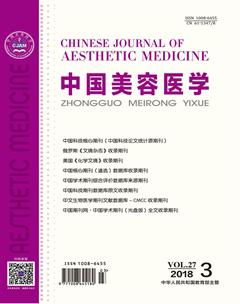成人双颌前突内收后切牙牙槽骨骨开窗率和骨开裂率的研究
朱明敏 李煌
[摘要]目的:利用三維CBCT评价成人双颌前突患者辅助种植支抗内收后切牙牙槽骨骨开窗率和骨开裂率的变化。方法:选取笔者科室2013年1月-2015年12月成人安氏Ⅰ类双颌前突需要减数4颗第一前磨牙、使用种植支抗内收的患者20例,其中男6例,女14例,平均年龄(22.8±3.0)岁。正畸治疗前后拍摄CBCT,观察切牙牙槽骨骨开裂、骨开窗情况,并进行统计学分析。结果:上颌切牙区共80颗牙,治疗前有18颗开窗,治疗后有26颗开窗,但无统计学意义;下颌切牙区共80颗牙,治疗前有8颗开窗,治疗后有15颗开窗,但无统计学意义。切牙区的牙槽骨开窗率比较,差异无统计学意义(P>0.05);上颌切牙区总共80颗牙,治疗前有3颗开裂,治疗后6颗开裂,上切牙区的牙槽骨开裂率卡方检验比较,差异无统计学意义(P>0.05);下颌切牙区总共80颗牙,治疗前10颗开裂,治疗后21颗开裂,下切牙区的牙槽骨开裂率比较有统计学意义(P<0.05)。结论:成人安氏Ⅰ类双颌前突患者辅助种植支抗内收后,切牙牙槽骨骨开窗无显著性变化,下切牙区牙槽骨骨开裂率有加重。提示口腔正畸医生应对下切牙的牙槽骨状况做密切关注。
[关键词]双颌前突;牙槽骨;骨开窗;骨开裂;CBCT
[中图分类号]R783.5 [文献标志码]A [文章编号]1008-6455(2018)03-0079-04
Evaluate Dehiscence and Fenestration of the Incisor Alveolar Bone after the Incisor Retraction in Adult Patients with Bimaxillary Protrusion
ZHU Ming-min1,2,LI Huang1
(1.Department of Orthodontics,Nanjing Stomatological Hospital,Medical School of Nanjing University, Nanjing 210093,Jiangsu,China; 2.Department of Orthodontics, Hospital of Stomatological of Wuxi,Wuxi 214000,Jiangsu,China)
Abstract: Objective Using three-dimensional CBCT to evaluate dehiscence and fenestration of the incisor alveolar bone after the incisor retraction in adult patients with bimaxillary protrusion. Methods Twenty adult patients (six males, fourteen females, mean age: 22.8±3.0) with Class1 bimaxillary protrusion were selected from January 1, 2013 to December 31, 2015.These patients extracted four first premolars used Micro- Implant anchorage to strengthened anchorage. The CBCT were taken before and after orthodontic treatment. Alveolar bone dehiscence and fenestration were observed and analyzed statistically . All statistical analyses were performed using SPSS23.0 statistical analysis software, using the χ2 test to compare the rate of alveolar bone fenestration and dehiscence before and after orthodontic treatment. Results A total of 80 teeth were found in the maxillary incisors, there were 18 teeth fenestration before treatment and 26 teeth fenestration after treatment, but do not have statistical significance. A total of 80 teeth were found in the mandibular incisor, there were 8 teeth fenestration before treatment and 15 teeth fenestration after treatment, but do not have statistical significance, there was no statistical significance in the fenestration rate of the incisor before and after the treatment(P>0.05). A total of 80 teeth were found in the maxillary incisors, there were 3 teeth dehiscence before treatment and 6 teeth dehiscence after treatment. There was no statistical significance in the dehiscence rate of the maxillary incisor before and after treatment(P>0.05). A total of 80 teeth were found in the in the mandibular incisor, there were 10 teeth dehiscence before treatment and 21 teeth dehiscence after treatment, There was statistical significance in the dehiscence rate of the mandibular incisor before and after treatment(P<0.05). Conclusion After using Micro-Implant in adult patients with Class1 bimaxillary protrusion, there was no significant change in the alveolar bone fenestration of the incisors , the rate of alveolar bone dehiscence increased in the mandibular incisor . It is suggested that orthodontist should pay close attention to the alveolar bone of the mandibular incisors.
Key words: bimaxillary protrusion; alveolar bone; dehiscence; fenestration; CBCT
牙周组织是人体独特的一种结构,通过牙槽骨、牙周膜、牙骨质和支持牙龈为牙齿提供支持和营养,牙槽骨是骨骼中代谢最活跃的部分,牙槽骨缺损可分为骨开窗(fenestration)和骨开裂(dehiscence)。牙槽嵴顶完整,根面牙槽骨缺损形成一圆形或椭圆形的裂孔被称为骨开窗。从牙槽骨边缘指向根尖的V形牙槽骨缺损被称为骨开裂。20世纪90年代,有学者[1]认为缺损达到釉牙骨质界(CEJ)下1mm即被认定为牙槽骨骨开裂,2010年,Evangelista等[2]认为缺损最低点要达到釉牙骨质界(CEJ)下2mm可被认定为牙槽骨骨开裂,Leung等[3]认为裂开是指从牙槽骨边缘指向根尖的V形缺损,位于牙齿的颊侧或舌侧,且缺损达到牙釉骨质界下方3mm以上才被认定为牙槽骨骨开裂。而Edels[4]是以牙齿邻面的牙槽嵴顶作为参考标准。关于牙槽骨骨开裂的诊断,目前公认牙槽骨骨开裂已累及牙槽骨边缘,但多大范围缺损可诊断为骨开裂目前世界上并没有统一的标准。与传统CT相比,CBCT能够评估不重叠邻近组织的实际解剖结构和减少辐射剂量及费用[5],与二维影像相比,能够三维影像清晰显示骨开窗和骨开裂[6]。本研究旨在采用CBCT测量安氏Ⅰ类双颌前突成人患者辅助种植支抗内收后评价成人双颌前突患者矫治前后骨开窗骨开裂的情况,分析种植钉辅助内收后双颌前突患者牙槽骨改建的特点,为口腔正畸临床提供科学依据。
1 资料和方法
1.1 研究对象:选择笔者科室2013年1月1日-2015年12月31日就诊的成人安氏Ⅰ类双颌前突需要减数4颗第一前磨牙的、使用种植支抗内收的患者20例。其中男6例,女14例,平均年龄(22.8±3.0)岁。
纳入标准:①成人(≥18周岁);②双颌前突,安氏I类错牙合,ANB角0~5°,牙列完整,上、下颌牙列轻度拥挤(拥挤度<3mm):磨牙I类关系,前牙覆牙合Ⅱ度以内、覆盖5mm以内;③治疗方案:拔除4颗第一前磨牙,采用种植支抗内收。
排除标准:①曾有固定矫治史;②前牙出现影像学可诊断的牙髓病变及根尖病变,曾有根管治疗史;③临床检查前牙牙周炎,附着丧失,X光片检查示牙槽骨吸收;④前牙数目形态异常及萌出异常;⑤全身系统性疾病史及长期药物使用史。
1.2 研究方法:正畸治疗前后拍摄CBCT,使用自带NNT Viewer软件。CBCT测量数据在编辑功能下从MPR窗口打开影像,选取受测牙水平横断面,将横断面调整至受测牙颈部,并调整使其通过牙体长轴。选定切牙区要测的牙位,在横断面上确定要测量的牙位,调节角度并让矢状向上的截面通过最大颊舌面(见图1),冠状纵切面上调整切片角度,使其通过牙体长轴(见图2),精细调整矢状纵切面使其经过牙尖及根尖(见图3),经过多次重复定位,精细调整,即能够得到矢状向上最大颊舌截面。观察20例患者矫治前牙齿的唇侧、舌侧的牙槽骨开裂开窗的情况,本实验采用的骨开裂标准是从牙骨釉质界到牙槽嵴顶的距离d>2mm,骨开窗、骨开裂示意图(见图4~5),测量标志点示意图(见图6)。
1.3 测量指标:牙槽骨骨开裂:釉牙骨质界到牙槽嵴顶的距离d(A-B)>2mm;牙槽骨骨开窗:牙槽嵴顶未累及的牙槽骨缺损的牙合、龈方界限的距离f(C-D)。
1.4 统计学处理:使用SPSS23.0统计分析软件,统计成人双颌前突患者切牙区唇侧牙槽骨骨开窗和骨开裂的数目。卡方检验对比内收前后切牙唇侧牙槽骨骨开窗、骨开裂的情况。
2 结果
在本研究中,没有发现1颗牙齿上既有骨开窗又有骨开裂,且观察到的骨开窗、骨开裂都在唇侧。上颌切牙区总共80颗牙,治疗前有18颗开窗,治疗后有26颗开窗,但无统计学意义;下颌切牙区总共80颗牙,治疗前有8颗开窗,治疗后有15颗开窗,但无统计学意义。切牙区的牙槽骨开窗率卡方检验两者差异无统计学意义(P>0.05)。上颌切牙区总共80颗牙,治疗前有3颗开裂,治疗后有6颗开裂,上切牙区的牙槽骨开裂率卡方检验两者差异无统计学意义(P>0.05),下颌切牙区总共80颗牙,治疗前有10颗开裂,治疗后有21颗开裂,下切牙区的牙槽骨开裂率卡方檢验两者差异无统计学意义 (P<0.05)。
3 讨论
在未经正畸治疗的人群中,广泛存在牙槽骨缺损[7-8]。由于诊断标准和研究方法的不同,对骨开窗、骨开裂的报道也各有差异。周琳、李巍然[9]运用CBCT来评价双颌前突患者的牙槽骨缺损情况,发现牙槽骨缺损较多地发生在唇(98.66%);牙槽骨开窗主要发生在上颌,而骨开裂主要发生在下颌。成人牙槽骨骨开裂(11.73%)及骨缺损(42.46%)。临床上诊断牙槽骨骨开窗有一定的难度,通过与传统的影像学诊断结合牙龈组织的信息,为评估牙槽骨高度和检查骨缺损的存在提供了参考信息,但它们很少能检测到骨开窗,Bagis等[10]则认为CBCT的诊断更为精准。Evangelista等[2]从既往研究干头颅的文献中发现骨开裂率为0.99%~13.4%,而骨开窗率为0.23%~16.9%;而通过CBCT研究发现骨开窗率为36.51%,骨开裂率为51.09%。Leung等[3]研究比较了CBCT与干颅检测出来骨开窗、骨开裂结果的区别,发现CBCT对骨开窗的敏感性及特异性在0.8左右,而对骨开裂的特异性高达0.95,而敏感性低于0.40,CBCT的结果可能存在假阳性。肉眼直视检查和测量使这种方法高度精确和可靠,然而,缺点是干性颅骨的研究没有提供临床资料,也没有牙科病史,且该方法不适用于临床外科诊断[11]。相反,在体内和体外研究表明,CBCT可以成为一个有用的、更可行的检测这些缺陷的临床工具。与传统CT比较,CBCT辐射低,图像质量出色,CBCT是诊断骨开窗的理想手段[12]。CBCT在诊断骨开窗、骨开裂上存在特异度高,但敏感性低。尽管CBCT检测的结果发生率有所夸大,但在目前CBCT检测还是较其他检测手段更为准确些。2012年,Yagci等[13]对123名成人的CBCT影像资料进行了统计学分析,表明骨开窗好发于上颌,骨开裂好发于下颌。这与本研究的结果一致。Hyo-Won Ahn等[14]发现上前牙区骨开窗、骨开裂的发生率较高,因为牙槽骨改建速度慢于前牙内收的速度。这种正畸前即存在的牙槽骨缺损,拍摄全景片及头颅侧位片是没有办法全面地发现,使用CBCT可以对牙槽骨形态进行三维方向的检查与分析。笔者的研究提示切牙在种植支抗的辅助内收后,上下颌切牙骨开窗和骨开裂的比率有所增加,但无统计学意义,这可能与样本数量有关,但提示正畸大范围内收切牙后可能会增加骨开窗和骨开裂的风险。骨开窗、骨开裂与牙齿移动的方式以及移动的速度有一定的关系,牙齿整体移动使其保持原有的角度在牙槽基骨中,避免接触牙槽骨界限,可降低发生牙槽骨缺损的风险。关于牙移动的最佳矫治力值尚未有统一的定论。目前临床上均建议使用轻力矫治,轻度力量在60g以下,中度力量为60~350g,重度力量在350g以上,本实验使用的内收力量在150g左右,属于中度力量,但这与所提倡的轻力矫治,我们设计的内收力量是否过大值得深入的研究。Kraus等[15]研究发现,使用轻中度力作用于成年狗第二前磨牙8周后,牙齿产生15.8°的倾斜移动和3.5mm的水平移动以及不同程度的骨开裂。对于双颌前突的患者,正畸治疗拔除4颗第一前磨牙利用最大支抗内收前牙,由于牙槽骨改建比较缓慢,以及前牙大距离的内收,会减少原有的牙槽骨厚度。本实验比较治疗前后的牙槽骨开窗率和开裂率,发现切牙区只有下切牙的开裂率比矫治前增加,有统计学意义,上下切牙区的开窗率无统计学意义,上切牙的开裂率也无统计学意义,那就说明下切牙区唇侧牙槽骨菲薄,正畸治疗后可能会导致牙槽骨开裂的情况加重。在治疗前就应该和患者做详细的沟通,告知正畸存在的风险及危险。因本次实验的样本量较小,以后还需要进一步的深入研究。
骨开窗、骨开裂使得牙齿周围的支持组织减少,众所周知,在炎症状态下或正畸治疗后,减少骨的支持可能会导致牙周健康恶化[16]。Yagci[13]研究对比了错牙合与骨开窗的相关性,发现安氏Ⅰ类、Ⅱ类、Ⅲ类错牙合畸形开窗存在明显差异,骨开窗多见于安氏Ⅱ类的上颌骨。有人发现安氏Ⅲ类错牙合骨开窗率高达31.93%[17]。Evangelista等[2]研究发现,安氏Ⅰ类患者的骨开裂率比安氏Ⅱ类1分类的患者的骨开裂率要高。Nahm等[18]研究发现安氏Ⅰ类双颌前突患者,在未进行正畸前就存在普遍的牙槽骨缺损。
综上所述,正畸医生应该高度重视牙槽骨的骨开窗和骨开裂,在制定正畸矫治方案前,对前牙区牙槽骨骨开窗和骨开裂做出全面评估,避免加重原有的牙槽骨缺损,避免牙根从薄弱的牙槽骨位置穿出。对于牙槽骨骨开窗和骨开裂出现的原因,可能与患者的年龄、牙齿异位、牙周炎症、根周围骨量、患者的全身因素等有关[19]。在矫治前,可以使用CBCT对前牙区牙槽骨进行全面精准的评估和分析,根据检查结果再制定治疗方案,尤其对成年双颌前突患者的前牙区进行检查[20-21],选择正畸治疗还是正畸正颌联合治疗,指导正畸医生更科学的治疗。咬合创伤可引起牙槽骨吸收,在个别牙反牙合的情况下可以清晰地看到牙槽骨的损伤,正畸治疗需尽快去除咬合创伤,避免牙槽骨骨缺损的进一步破坏。因颌骨的解剖特性,前牙区牙槽骨较薄弱,尤其在前牙大范围地内收后,易发生牙槽骨吸收,正畸过程中应该密切关注前牙的倾斜度,防止前牙过度唇倾或舌倾,尽量保证牙根在牙槽骨中运动[22-23];在正畸治疗过程中要严密监测前牙区牙槽骨骨量。正畸控根移动往往需要加转矩控制,但控根移动会使牙槽骨吸收以及根吸收的风险增加,在正畸治疗中要注意力量适中,避免加载过大转矩,避免在矫正过程中引起和加重骨开裂和骨开窗的发生。牙龈炎与牙周炎也是骨开窗与骨开裂的诱发因素,正畸治疗前应进行牙周基础治疗口腔卫生宣教,治疗中严密监测牙周情况,防止牙龈炎牙周炎的发生,最大限度地维护牙周组织健康。采用正确的刷牙方式,防止不正确的刷牙方式导致骨开裂与骨开窗的发生[24]。正畸医生应当充分了解这些因素,减少矫治力对牙周组织的不良反应,尤其是下切牙区这种牙槽骨薄弱区域,尽量减少对牙槽骨的损害。
[参考文献]
[1]Jorgic-Srdjak K,Plancak D,Bosnjak A,et al.Incidence and dis-tribution of dehiscences and fenestrations on human skulls [J].Coll Antropol,1998,22 (Suppl):111-116.
[2]Evangelista K,VasconcelosKde F,Bumann A,et al.Dehiscenceand fenestration in patients with Class Ⅰ and Class Ⅱ Division 1malocclusion assessed with cone-beam computed tomography[J].Am J Orthod Dentofacial Orthop,2010,138 (2): 133-135.
[3]Leung CC,Palomo L,Griffith R,et al.Accuracy and reliability of cone-beam computed tomography for measuring alveolar boneheight and detecting bony dehiscences and fenestrations[J].Am J Orthod Dentofacial Orthop,2010,137 (4): 109-119.
[4]Edels A.Alveolar bone fenestrations and dehiscences in dryBedouin jaws[J].J Clin Periodontol,1981,8(6):491-499.
[5]Baysal A,Uysal T,Veli I,et al.Evaluation of alveolar bone loss following rapid maxillary expansion using cone-beamcomputed tomography[J].Korean J Orthod,2013,43:83-95.
[6]Enhos S,Uysal T,Yagci A,et al.Dehiscence and fenestration in patients with different vertical growth patterns assessed with cone-beam computed tomography[J].Angle Orthod,2012,82:868-874.
[7]刘敏,周力,王艳民.正畸相关牙槽骨缺损现象的研究现状[J].国际口腔医学杂志,2013,40(4):500-502.
[8]Guo QY,Zhang SJ,Liu H,et al.Three-dimensional evaluation ofupper anterior alveolar bone dehiscence after incisor retraction and intrusion in adult patients with bimaxillary protrusion malocclusion[J].J Zhejiang Univ Sci B,2011,12(12):990-997.
[9]周琳,李巍然.錐体束CT在评价双颌前突患者前牙区牙槽骨缺损中的应用[J].北京大学学报(医学版),2015,47(3):514-520.
[10]Bagis N,Kolsuz ME,Kursun S,et al.Comparison of intraoral radiography and cone-beam computed tomography for the detection of periodontal defects:an in vitro study[J].BMC Oral Health,2015,15:64.
[11]Pan HY,Yang H,Zhang R,et al.Use of cone-beamcomputed tomography to evaluate the prevalence of root fenestration in a Chinese subpopulation[J].Int Endodont J,2014,14(1):10-19.
[12]Kasaj A,Willershausen B.Digital volume tomography for diagnostics in periodontology[J].Int J Comput Dent,2007,10(1):155-168.
[13]Yagci A,Veli I,Uysal T,et al.Dehiscence and fenestration in skeletal ClassⅠ,Ⅱ, and Ⅲ malocclusions assessed with cone -beam computed tomography [J]. Angle Orthod,2012,82(1):67-74.
[14]Hyo-Won Ahn,Sung Chul Moon,Seung-Hak Baek,et al. Morphometric evaluation of changes in the alveolar bone and roots ofthe maxillary anterior teeth before and after en masse retraction usingcone-beamcomputed tomography[J].Angle Orthod,2013,83(2):212-221.
[15]Kraus CD,Campbell PM,Spears R,et al.Bony adaptation after expansion with light to moderate continuous forces[J].Am J Orthod Dentofacial Orthop,2014,145(5):655-666.
[16]Buyuk SK,Ercan E,Celikoglu M ,et al.Evaluation of dehiscence and fenestration in adolescent patients affected by unilateral cleft lip and palate[J].Angle Orthod,2016,86(3):431-436.
[17]孙良龚,王博,房兵.骨性Ⅲ类错牙合前牙区牙槽骨开裂和牙槽骨开窗发生率的锥形束CT研究[J].上海口腔医学,2013,22(4):418-422.
[18]Nahm KY, Kang JH, Moon SC, et al. Alveolar bone loss around incisors in ClassⅠbidentoalveolar protrusion patients:a retrospective three-dimensional cone beam CT study[J].Dentomaxillofac Radiol,2012,41(6):481-488.
[19]Lustig JP,Tamse A,Fuss Z.Pattern of bone resorption in vertically fractured, endodontically treated teeth[J].Oral Surg Oral Med Oral Pathol Oral Radiol Endod, 2000,90(2):224-7.
[20]Kapila SD,Nervina JM. CBCT in orthodontics:assessment oftreatment outcomes and indications for its use[J]. Dentomaxillofac Radiol,2015,44(1):20140282.
[21]Garib DG,Yatabe MS,Ozawa TO,et al. Alveolar bone morphology in patients with bilateral complete cleft lip and palate in themixed dentition:cone beam computed tomography evaluation[J].Cleft Palate Craniofac,2012,49(2):208-214.
[22]Saxena R,Kumar PS,Upadhyay M,et al.A clinical evaluationof orthodontic mini-implants as intraoral anchorage for the intrusion of maxillary anterior teeth[J].World J Orthod,2010,11(4):346-351.
[23]Gkantidis N,Christou P,Topouzelis N.The orthodontic-periodontic interrelationship in integrated treatment challenges:asystematic review[J]. J Oral Rehabil,2010,37(5):377-390.
[23]王文芳,李志華.牙槽骨开裂与开窗的研究进展[J].中华口腔医学杂志,2013,48(9):570-572.
[收稿日期]2018-01-25 [修回日期]2018-03-01
编辑/李阳利

